Fit Flop Case Study: Leadership, Culture, Motivation and Teamwork
VerifiedAdded on 2023/06/15
|13
|3477
|486
Report
AI Summary
This report analyzes the role of leadership, organizational structure, and culture within the context of the Fit Flop company, a globally recognized footwear brand. It examines the participatory leadership style employed by Fit Flop, emphasizing employee involvement in decision-making, and explores various leadership roles such as trainer, motivator, mentor, communicator, and navigator. The report also delves into how organizational structure and culture, particularly through Handy's cultural model (role, task, power, and personal cultures), can support effective transitional change. Furthermore, it evaluates methods for building effective teams through motivation, discussing theories like Maslow's hierarchy of needs and Herzberg's two-factor theory. The analysis identifies team development attributes that can contribute to Fit Flop's success, providing insights into motivation, team dynamics, and organizational strategy.
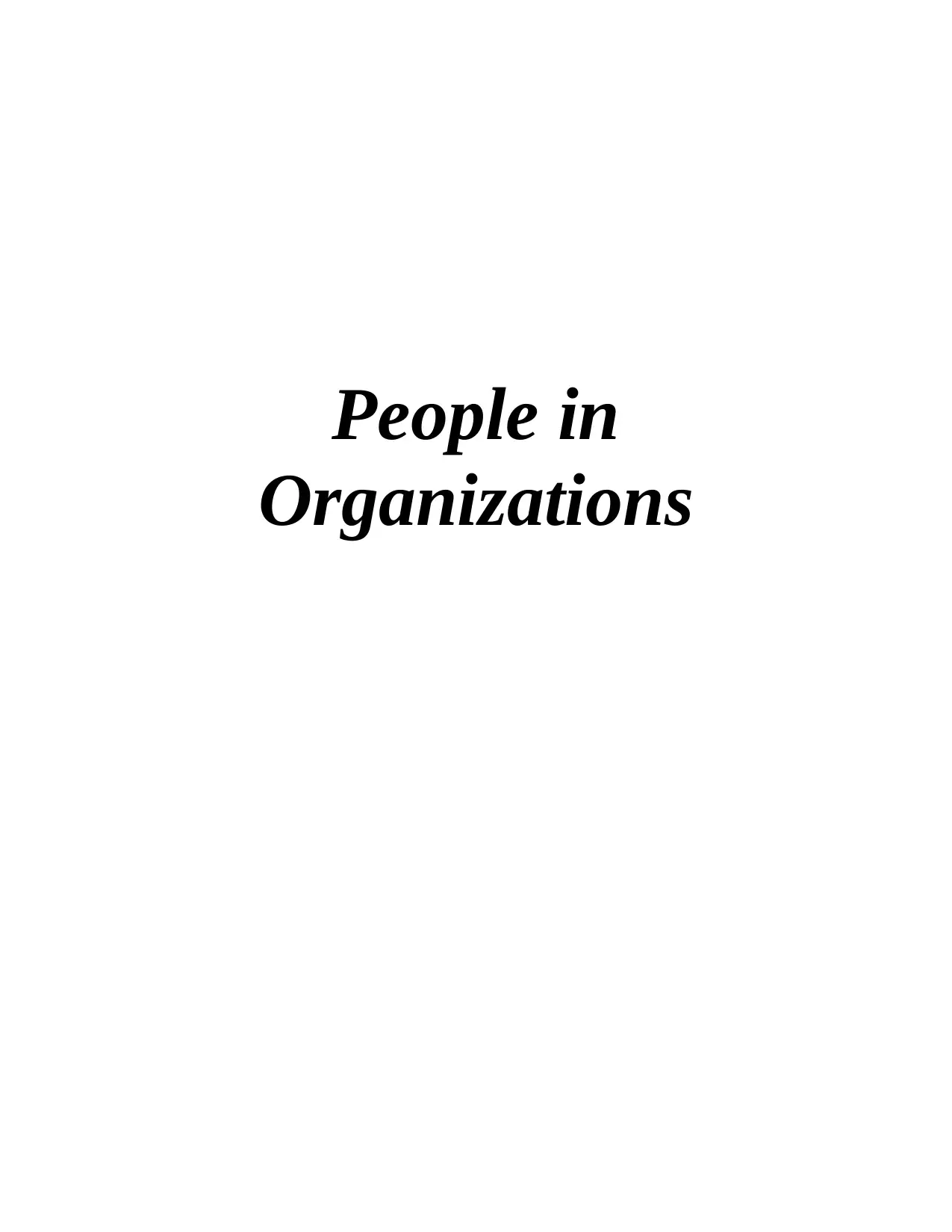
People in
Organizations
Organizations
Paraphrase This Document
Need a fresh take? Get an instant paraphrase of this document with our AI Paraphraser
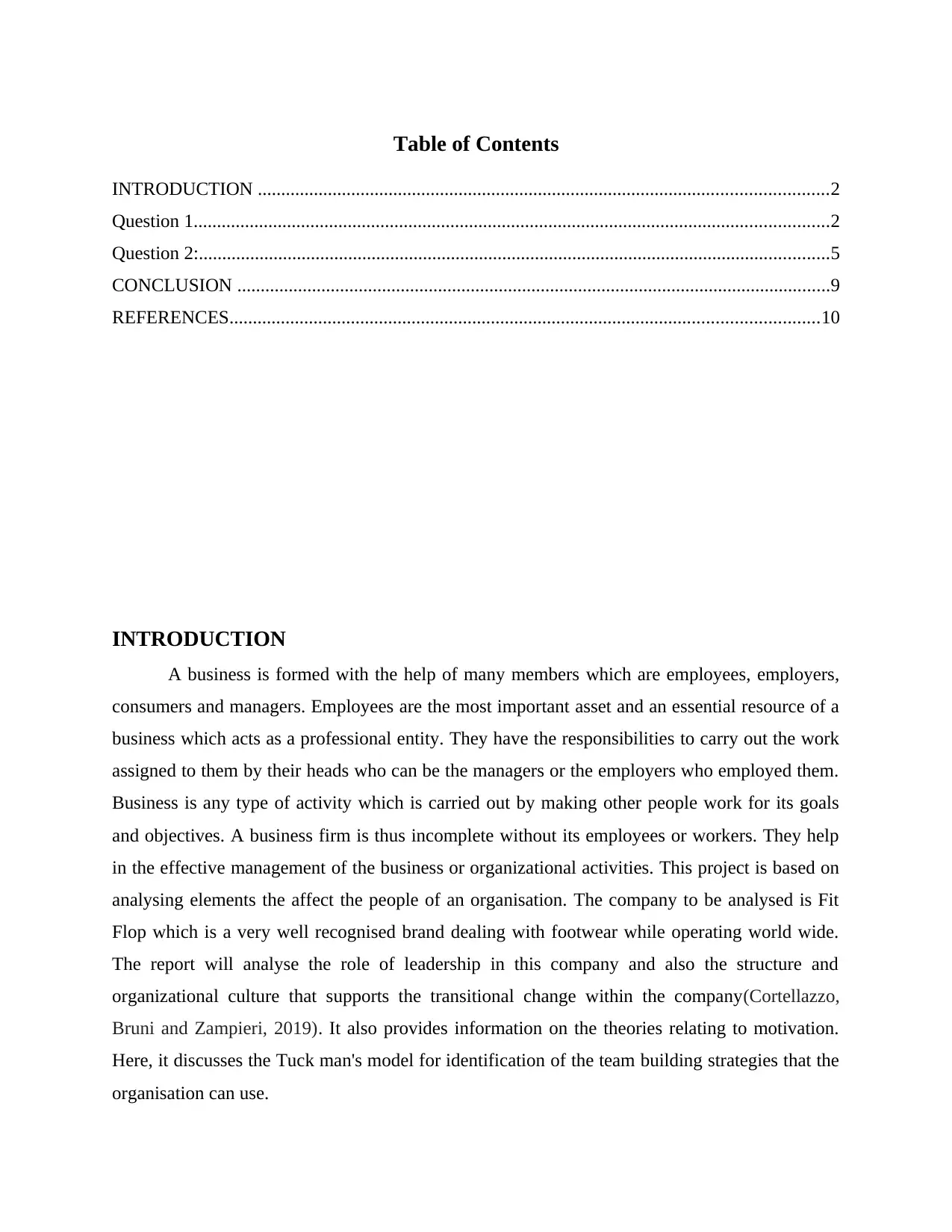
Table of Contents
INTRODUCTION ..........................................................................................................................2
Question 1........................................................................................................................................2
Question 2:.......................................................................................................................................5
CONCLUSION ...............................................................................................................................9
REFERENCES..............................................................................................................................10
INTRODUCTION
A business is formed with the help of many members which are employees, employers,
consumers and managers. Employees are the most important asset and an essential resource of a
business which acts as a professional entity. They have the responsibilities to carry out the work
assigned to them by their heads who can be the managers or the employers who employed them.
Business is any type of activity which is carried out by making other people work for its goals
and objectives. A business firm is thus incomplete without its employees or workers. They help
in the effective management of the business or organizational activities. This project is based on
analysing elements the affect the people of an organisation. The company to be analysed is Fit
Flop which is a very well recognised brand dealing with footwear while operating world wide.
The report will analyse the role of leadership in this company and also the structure and
organizational culture that supports the transitional change within the company(Cortellazzo,
Bruni and Zampieri, 2019). It also provides information on the theories relating to motivation.
Here, it discusses the Tuck man's model for identification of the team building strategies that the
organisation can use.
INTRODUCTION ..........................................................................................................................2
Question 1........................................................................................................................................2
Question 2:.......................................................................................................................................5
CONCLUSION ...............................................................................................................................9
REFERENCES..............................................................................................................................10
INTRODUCTION
A business is formed with the help of many members which are employees, employers,
consumers and managers. Employees are the most important asset and an essential resource of a
business which acts as a professional entity. They have the responsibilities to carry out the work
assigned to them by their heads who can be the managers or the employers who employed them.
Business is any type of activity which is carried out by making other people work for its goals
and objectives. A business firm is thus incomplete without its employees or workers. They help
in the effective management of the business or organizational activities. This project is based on
analysing elements the affect the people of an organisation. The company to be analysed is Fit
Flop which is a very well recognised brand dealing with footwear while operating world wide.
The report will analyse the role of leadership in this company and also the structure and
organizational culture that supports the transitional change within the company(Cortellazzo,
Bruni and Zampieri, 2019). It also provides information on the theories relating to motivation.
Here, it discusses the Tuck man's model for identification of the team building strategies that the
organisation can use.
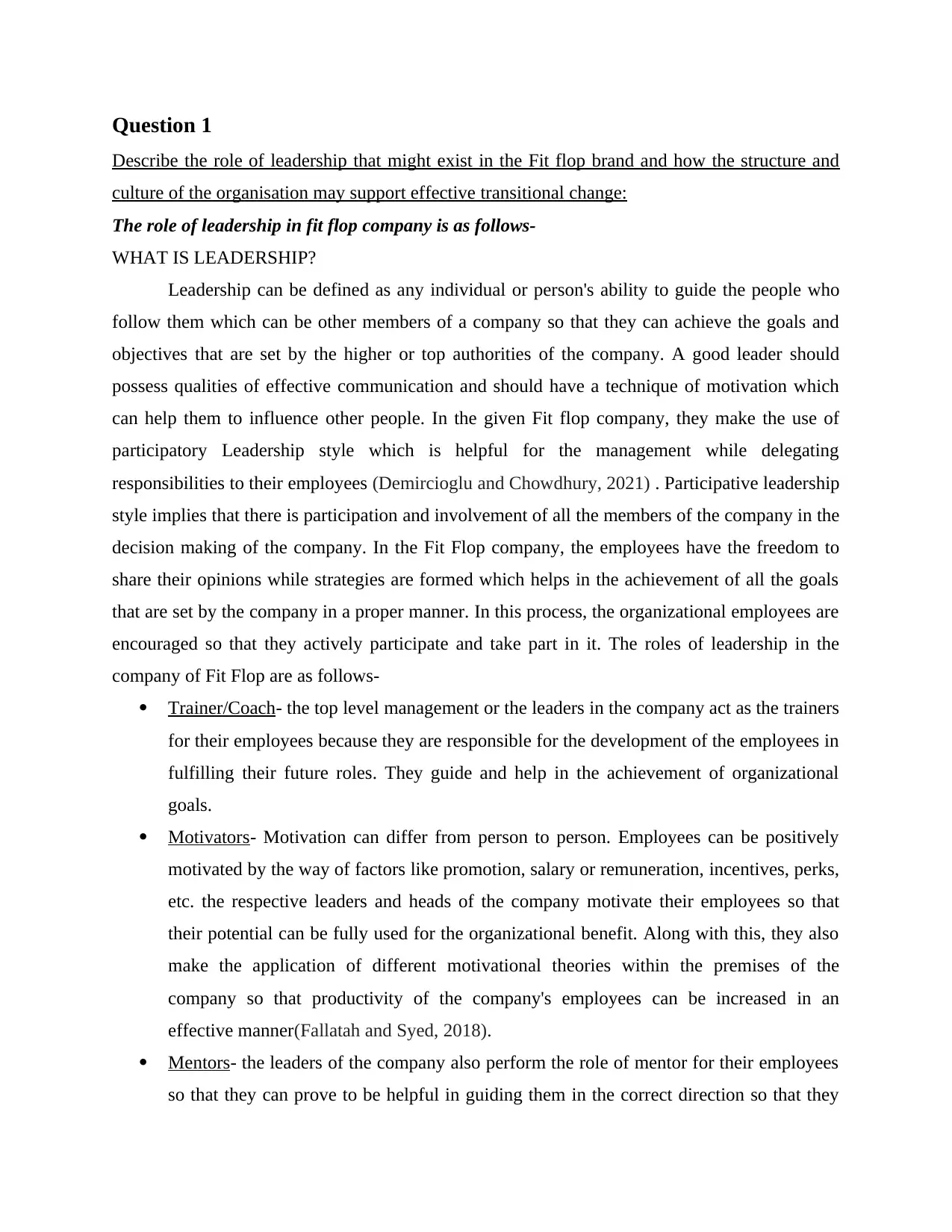
Question 1
Describe the role of leadership that might exist in the Fit flop brand and how the structure and
culture of the organisation may support effective transitional change:
The role of leadership in fit flop company is as follows-
WHAT IS LEADERSHIP?
Leadership can be defined as any individual or person's ability to guide the people who
follow them which can be other members of a company so that they can achieve the goals and
objectives that are set by the higher or top authorities of the company. A good leader should
possess qualities of effective communication and should have a technique of motivation which
can help them to influence other people. In the given Fit flop company, they make the use of
participatory Leadership style which is helpful for the management while delegating
responsibilities to their employees (Demircioglu and Chowdhury, 2021) . Participative leadership
style implies that there is participation and involvement of all the members of the company in the
decision making of the company. In the Fit Flop company, the employees have the freedom to
share their opinions while strategies are formed which helps in the achievement of all the goals
that are set by the company in a proper manner. In this process, the organizational employees are
encouraged so that they actively participate and take part in it. The roles of leadership in the
company of Fit Flop are as follows-
Trainer/Coach- the top level management or the leaders in the company act as the trainers
for their employees because they are responsible for the development of the employees in
fulfilling their future roles. They guide and help in the achievement of organizational
goals.
Motivators- Motivation can differ from person to person. Employees can be positively
motivated by the way of factors like promotion, salary or remuneration, incentives, perks,
etc. the respective leaders and heads of the company motivate their employees so that
their potential can be fully used for the organizational benefit. Along with this, they also
make the application of different motivational theories within the premises of the
company so that productivity of the company's employees can be increased in an
effective manner(Fallatah and Syed, 2018).
Mentors- the leaders of the company also perform the role of mentor for their employees
so that they can prove to be helpful in guiding them in the correct direction so that they
Describe the role of leadership that might exist in the Fit flop brand and how the structure and
culture of the organisation may support effective transitional change:
The role of leadership in fit flop company is as follows-
WHAT IS LEADERSHIP?
Leadership can be defined as any individual or person's ability to guide the people who
follow them which can be other members of a company so that they can achieve the goals and
objectives that are set by the higher or top authorities of the company. A good leader should
possess qualities of effective communication and should have a technique of motivation which
can help them to influence other people. In the given Fit flop company, they make the use of
participatory Leadership style which is helpful for the management while delegating
responsibilities to their employees (Demircioglu and Chowdhury, 2021) . Participative leadership
style implies that there is participation and involvement of all the members of the company in the
decision making of the company. In the Fit Flop company, the employees have the freedom to
share their opinions while strategies are formed which helps in the achievement of all the goals
that are set by the company in a proper manner. In this process, the organizational employees are
encouraged so that they actively participate and take part in it. The roles of leadership in the
company of Fit Flop are as follows-
Trainer/Coach- the top level management or the leaders in the company act as the trainers
for their employees because they are responsible for the development of the employees in
fulfilling their future roles. They guide and help in the achievement of organizational
goals.
Motivators- Motivation can differ from person to person. Employees can be positively
motivated by the way of factors like promotion, salary or remuneration, incentives, perks,
etc. the respective leaders and heads of the company motivate their employees so that
their potential can be fully used for the organizational benefit. Along with this, they also
make the application of different motivational theories within the premises of the
company so that productivity of the company's employees can be increased in an
effective manner(Fallatah and Syed, 2018).
Mentors- the leaders of the company also perform the role of mentor for their employees
so that they can prove to be helpful in guiding them in the correct direction so that they
⊘ This is a preview!⊘
Do you want full access?
Subscribe today to unlock all pages.

Trusted by 1+ million students worldwide
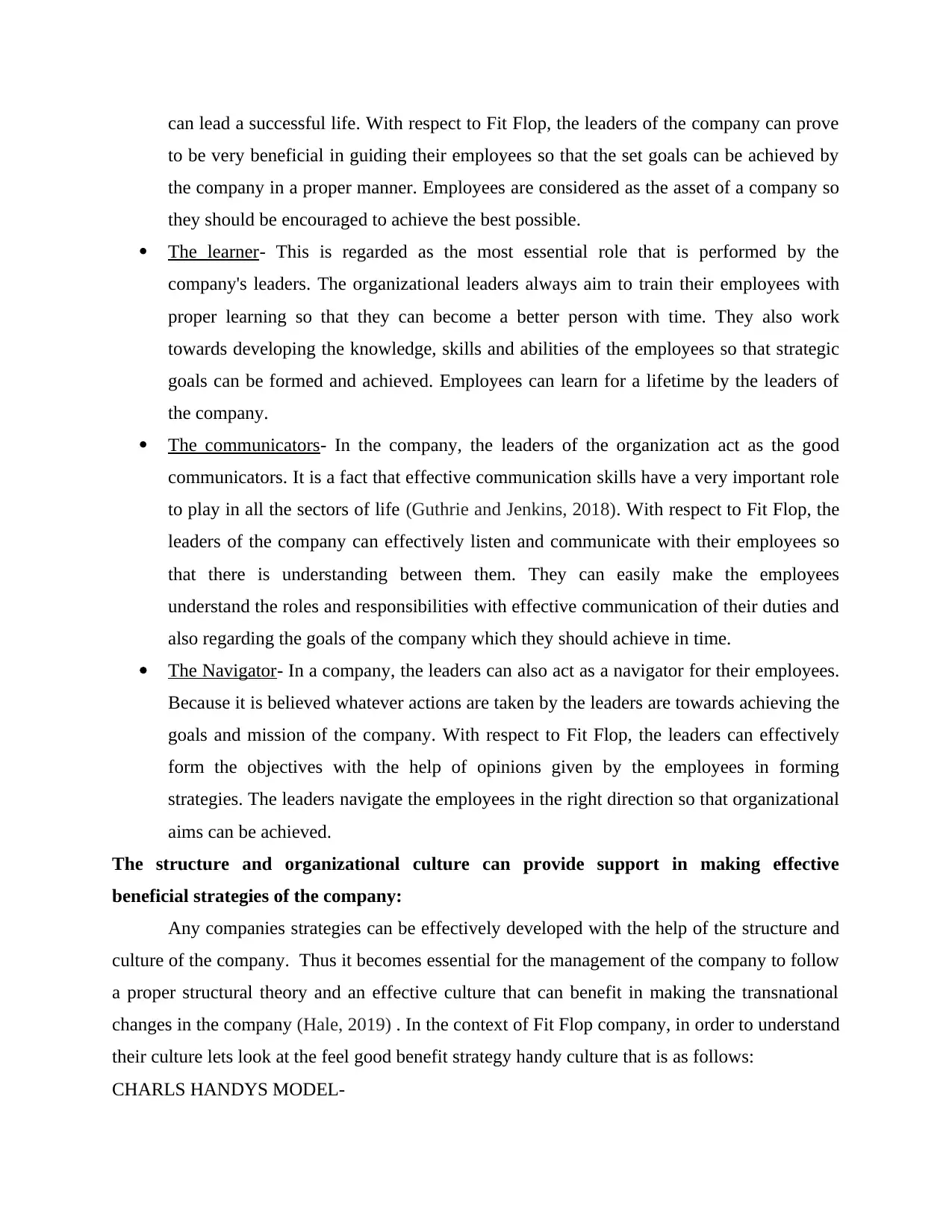
can lead a successful life. With respect to Fit Flop, the leaders of the company can prove
to be very beneficial in guiding their employees so that the set goals can be achieved by
the company in a proper manner. Employees are considered as the asset of a company so
they should be encouraged to achieve the best possible.
The learner- This is regarded as the most essential role that is performed by the
company's leaders. The organizational leaders always aim to train their employees with
proper learning so that they can become a better person with time. They also work
towards developing the knowledge, skills and abilities of the employees so that strategic
goals can be formed and achieved. Employees can learn for a lifetime by the leaders of
the company.
The communicators- In the company, the leaders of the organization act as the good
communicators. It is a fact that effective communication skills have a very important role
to play in all the sectors of life (Guthrie and Jenkins, 2018). With respect to Fit Flop, the
leaders of the company can effectively listen and communicate with their employees so
that there is understanding between them. They can easily make the employees
understand the roles and responsibilities with effective communication of their duties and
also regarding the goals of the company which they should achieve in time.
The Navigator- In a company, the leaders can also act as a navigator for their employees.
Because it is believed whatever actions are taken by the leaders are towards achieving the
goals and mission of the company. With respect to Fit Flop, the leaders can effectively
form the objectives with the help of opinions given by the employees in forming
strategies. The leaders navigate the employees in the right direction so that organizational
aims can be achieved.
The structure and organizational culture can provide support in making effective
beneficial strategies of the company:
Any companies strategies can be effectively developed with the help of the structure and
culture of the company. Thus it becomes essential for the management of the company to follow
a proper structural theory and an effective culture that can benefit in making the transnational
changes in the company (Hale, 2019) . In the context of Fit Flop company, in order to understand
their culture lets look at the feel good benefit strategy handy culture that is as follows:
CHARLS HANDYS MODEL-
to be very beneficial in guiding their employees so that the set goals can be achieved by
the company in a proper manner. Employees are considered as the asset of a company so
they should be encouraged to achieve the best possible.
The learner- This is regarded as the most essential role that is performed by the
company's leaders. The organizational leaders always aim to train their employees with
proper learning so that they can become a better person with time. They also work
towards developing the knowledge, skills and abilities of the employees so that strategic
goals can be formed and achieved. Employees can learn for a lifetime by the leaders of
the company.
The communicators- In the company, the leaders of the organization act as the good
communicators. It is a fact that effective communication skills have a very important role
to play in all the sectors of life (Guthrie and Jenkins, 2018). With respect to Fit Flop, the
leaders of the company can effectively listen and communicate with their employees so
that there is understanding between them. They can easily make the employees
understand the roles and responsibilities with effective communication of their duties and
also regarding the goals of the company which they should achieve in time.
The Navigator- In a company, the leaders can also act as a navigator for their employees.
Because it is believed whatever actions are taken by the leaders are towards achieving the
goals and mission of the company. With respect to Fit Flop, the leaders can effectively
form the objectives with the help of opinions given by the employees in forming
strategies. The leaders navigate the employees in the right direction so that organizational
aims can be achieved.
The structure and organizational culture can provide support in making effective
beneficial strategies of the company:
Any companies strategies can be effectively developed with the help of the structure and
culture of the company. Thus it becomes essential for the management of the company to follow
a proper structural theory and an effective culture that can benefit in making the transnational
changes in the company (Hale, 2019) . In the context of Fit Flop company, in order to understand
their culture lets look at the feel good benefit strategy handy culture that is as follows:
CHARLS HANDYS MODEL-
Paraphrase This Document
Need a fresh take? Get an instant paraphrase of this document with our AI Paraphraser
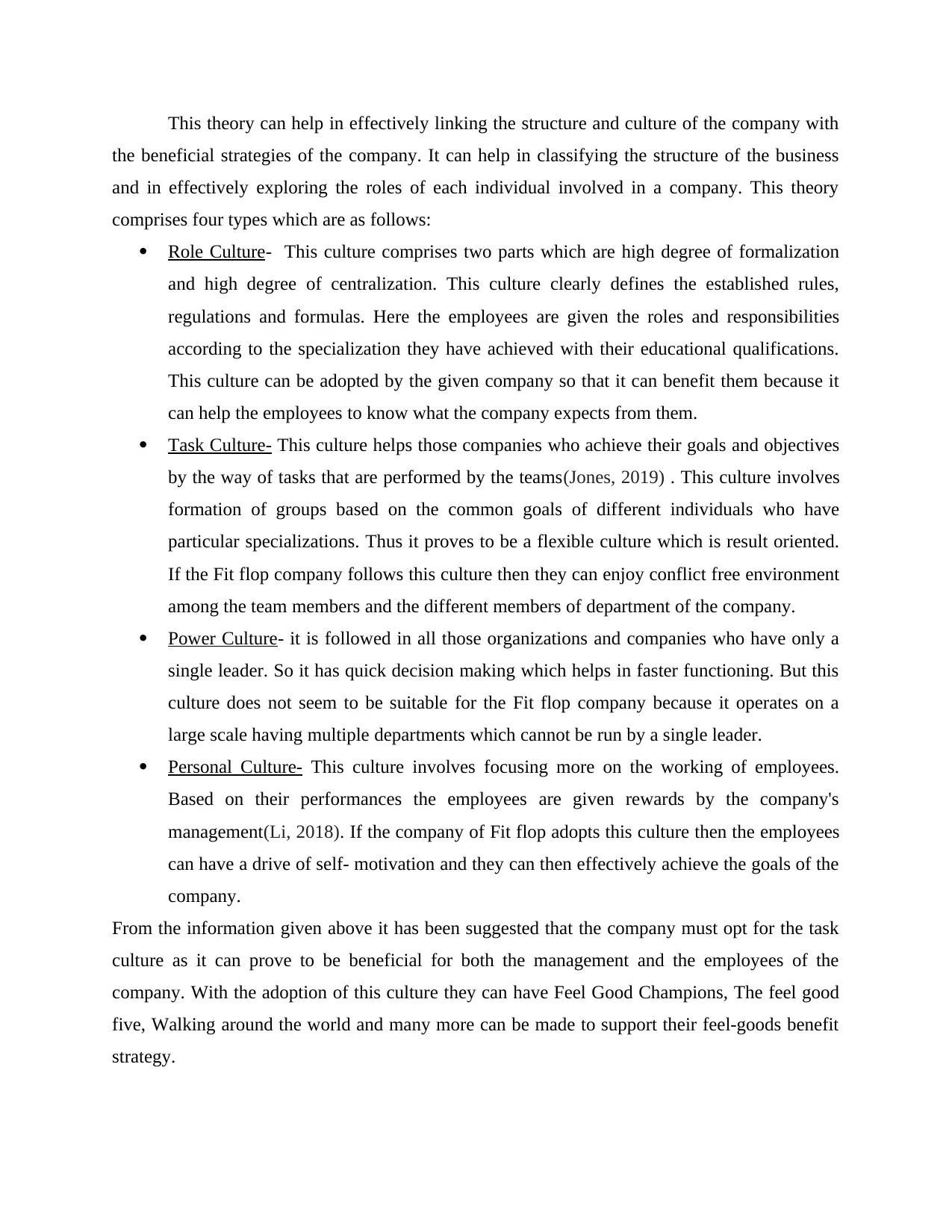
This theory can help in effectively linking the structure and culture of the company with
the beneficial strategies of the company. It can help in classifying the structure of the business
and in effectively exploring the roles of each individual involved in a company. This theory
comprises four types which are as follows:
Role Culture- This culture comprises two parts which are high degree of formalization
and high degree of centralization. This culture clearly defines the established rules,
regulations and formulas. Here the employees are given the roles and responsibilities
according to the specialization they have achieved with their educational qualifications.
This culture can be adopted by the given company so that it can benefit them because it
can help the employees to know what the company expects from them.
Task Culture- This culture helps those companies who achieve their goals and objectives
by the way of tasks that are performed by the teams(Jones, 2019) . This culture involves
formation of groups based on the common goals of different individuals who have
particular specializations. Thus it proves to be a flexible culture which is result oriented.
If the Fit flop company follows this culture then they can enjoy conflict free environment
among the team members and the different members of department of the company.
Power Culture- it is followed in all those organizations and companies who have only a
single leader. So it has quick decision making which helps in faster functioning. But this
culture does not seem to be suitable for the Fit flop company because it operates on a
large scale having multiple departments which cannot be run by a single leader.
Personal Culture- This culture involves focusing more on the working of employees.
Based on their performances the employees are given rewards by the company's
management(Li, 2018). If the company of Fit flop adopts this culture then the employees
can have a drive of self- motivation and they can then effectively achieve the goals of the
company.
From the information given above it has been suggested that the company must opt for the task
culture as it can prove to be beneficial for both the management and the employees of the
company. With the adoption of this culture they can have Feel Good Champions, The feel good
five, Walking around the world and many more can be made to support their feel-goods benefit
strategy.
the beneficial strategies of the company. It can help in classifying the structure of the business
and in effectively exploring the roles of each individual involved in a company. This theory
comprises four types which are as follows:
Role Culture- This culture comprises two parts which are high degree of formalization
and high degree of centralization. This culture clearly defines the established rules,
regulations and formulas. Here the employees are given the roles and responsibilities
according to the specialization they have achieved with their educational qualifications.
This culture can be adopted by the given company so that it can benefit them because it
can help the employees to know what the company expects from them.
Task Culture- This culture helps those companies who achieve their goals and objectives
by the way of tasks that are performed by the teams(Jones, 2019) . This culture involves
formation of groups based on the common goals of different individuals who have
particular specializations. Thus it proves to be a flexible culture which is result oriented.
If the Fit flop company follows this culture then they can enjoy conflict free environment
among the team members and the different members of department of the company.
Power Culture- it is followed in all those organizations and companies who have only a
single leader. So it has quick decision making which helps in faster functioning. But this
culture does not seem to be suitable for the Fit flop company because it operates on a
large scale having multiple departments which cannot be run by a single leader.
Personal Culture- This culture involves focusing more on the working of employees.
Based on their performances the employees are given rewards by the company's
management(Li, 2018). If the company of Fit flop adopts this culture then the employees
can have a drive of self- motivation and they can then effectively achieve the goals of the
company.
From the information given above it has been suggested that the company must opt for the task
culture as it can prove to be beneficial for both the management and the employees of the
company. With the adoption of this culture they can have Feel Good Champions, The feel good
five, Walking around the world and many more can be made to support their feel-goods benefit
strategy.
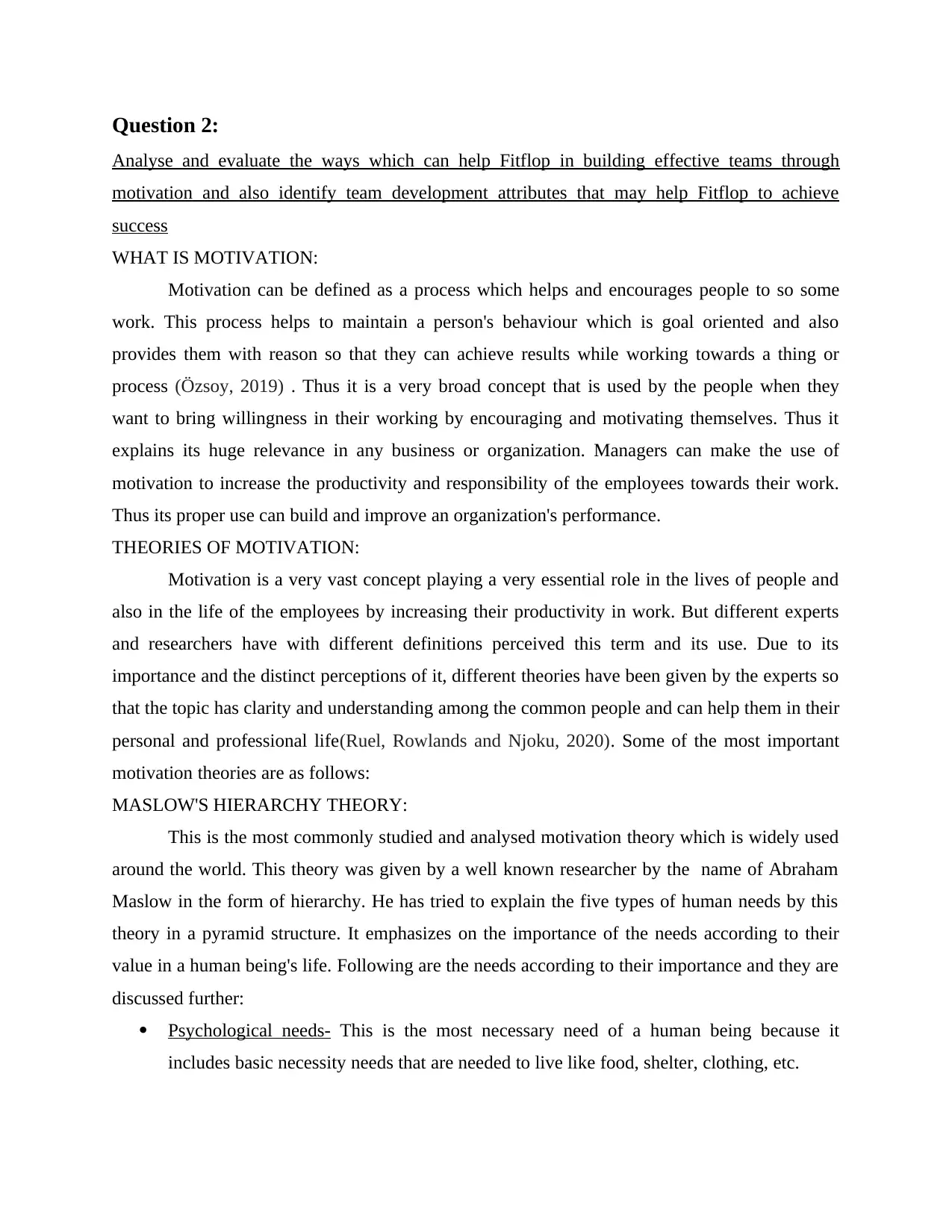
Question 2:
Analyse and evaluate the ways which can help Fitflop in building effective teams through
motivation and also identify team development attributes that may help Fitflop to achieve
success
WHAT IS MOTIVATION:
Motivation can be defined as a process which helps and encourages people to so some
work. This process helps to maintain a person's behaviour which is goal oriented and also
provides them with reason so that they can achieve results while working towards a thing or
process (Özsoy, 2019) . Thus it is a very broad concept that is used by the people when they
want to bring willingness in their working by encouraging and motivating themselves. Thus it
explains its huge relevance in any business or organization. Managers can make the use of
motivation to increase the productivity and responsibility of the employees towards their work.
Thus its proper use can build and improve an organization's performance.
THEORIES OF MOTIVATION:
Motivation is a very vast concept playing a very essential role in the lives of people and
also in the life of the employees by increasing their productivity in work. But different experts
and researchers have with different definitions perceived this term and its use. Due to its
importance and the distinct perceptions of it, different theories have been given by the experts so
that the topic has clarity and understanding among the common people and can help them in their
personal and professional life(Ruel, Rowlands and Njoku, 2020). Some of the most important
motivation theories are as follows:
MASLOW'S HIERARCHY THEORY:
This is the most commonly studied and analysed motivation theory which is widely used
around the world. This theory was given by a well known researcher by the name of Abraham
Maslow in the form of hierarchy. He has tried to explain the five types of human needs by this
theory in a pyramid structure. It emphasizes on the importance of the needs according to their
value in a human being's life. Following are the needs according to their importance and they are
discussed further:
Psychological needs- This is the most necessary need of a human being because it
includes basic necessity needs that are needed to live like food, shelter, clothing, etc.
Analyse and evaluate the ways which can help Fitflop in building effective teams through
motivation and also identify team development attributes that may help Fitflop to achieve
success
WHAT IS MOTIVATION:
Motivation can be defined as a process which helps and encourages people to so some
work. This process helps to maintain a person's behaviour which is goal oriented and also
provides them with reason so that they can achieve results while working towards a thing or
process (Özsoy, 2019) . Thus it is a very broad concept that is used by the people when they
want to bring willingness in their working by encouraging and motivating themselves. Thus it
explains its huge relevance in any business or organization. Managers can make the use of
motivation to increase the productivity and responsibility of the employees towards their work.
Thus its proper use can build and improve an organization's performance.
THEORIES OF MOTIVATION:
Motivation is a very vast concept playing a very essential role in the lives of people and
also in the life of the employees by increasing their productivity in work. But different experts
and researchers have with different definitions perceived this term and its use. Due to its
importance and the distinct perceptions of it, different theories have been given by the experts so
that the topic has clarity and understanding among the common people and can help them in their
personal and professional life(Ruel, Rowlands and Njoku, 2020). Some of the most important
motivation theories are as follows:
MASLOW'S HIERARCHY THEORY:
This is the most commonly studied and analysed motivation theory which is widely used
around the world. This theory was given by a well known researcher by the name of Abraham
Maslow in the form of hierarchy. He has tried to explain the five types of human needs by this
theory in a pyramid structure. It emphasizes on the importance of the needs according to their
value in a human being's life. Following are the needs according to their importance and they are
discussed further:
Psychological needs- This is the most necessary need of a human being because it
includes basic necessity needs that are needed to live like food, shelter, clothing, etc.
⊘ This is a preview!⊘
Do you want full access?
Subscribe today to unlock all pages.

Trusted by 1+ million students worldwide
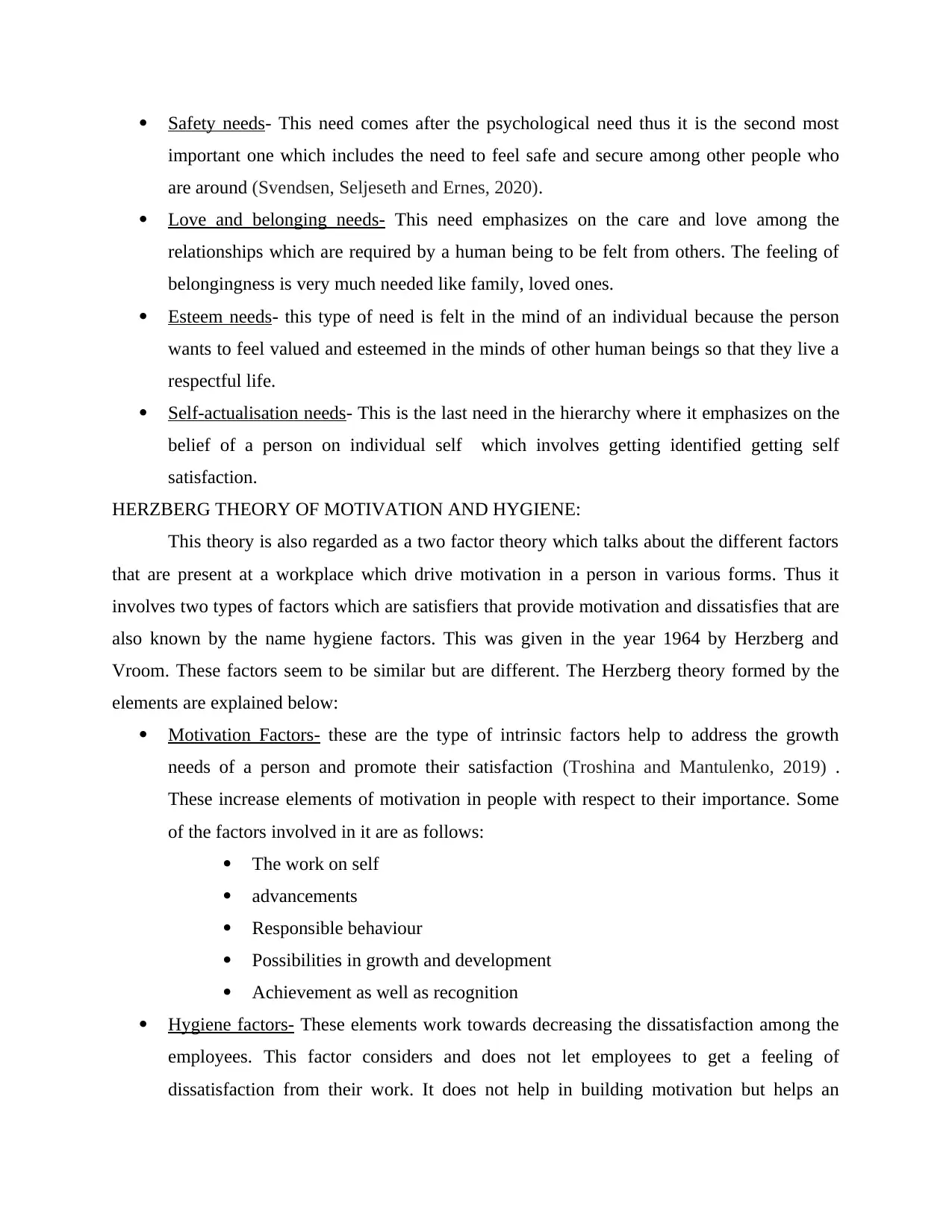
Safety needs- This need comes after the psychological need thus it is the second most
important one which includes the need to feel safe and secure among other people who
are around (Svendsen, Seljeseth and Ernes, 2020).
Love and belonging needs- This need emphasizes on the care and love among the
relationships which are required by a human being to be felt from others. The feeling of
belongingness is very much needed like family, loved ones.
Esteem needs- this type of need is felt in the mind of an individual because the person
wants to feel valued and esteemed in the minds of other human beings so that they live a
respectful life.
Self-actualisation needs- This is the last need in the hierarchy where it emphasizes on the
belief of a person on individual self which involves getting identified getting self
satisfaction.
HERZBERG THEORY OF MOTIVATION AND HYGIENE:
This theory is also regarded as a two factor theory which talks about the different factors
that are present at a workplace which drive motivation in a person in various forms. Thus it
involves two types of factors which are satisfiers that provide motivation and dissatisfies that are
also known by the name hygiene factors. This was given in the year 1964 by Herzberg and
Vroom. These factors seem to be similar but are different. The Herzberg theory formed by the
elements are explained below:
Motivation Factors- these are the type of intrinsic factors help to address the growth
needs of a person and promote their satisfaction (Troshina and Mantulenko, 2019) .
These increase elements of motivation in people with respect to their importance. Some
of the factors involved in it are as follows:
The work on self
advancements
Responsible behaviour
Possibilities in growth and development
Achievement as well as recognition
Hygiene factors- These elements work towards decreasing the dissatisfaction among the
employees. This factor considers and does not let employees to get a feeling of
dissatisfaction from their work. It does not help in building motivation but helps an
important one which includes the need to feel safe and secure among other people who
are around (Svendsen, Seljeseth and Ernes, 2020).
Love and belonging needs- This need emphasizes on the care and love among the
relationships which are required by a human being to be felt from others. The feeling of
belongingness is very much needed like family, loved ones.
Esteem needs- this type of need is felt in the mind of an individual because the person
wants to feel valued and esteemed in the minds of other human beings so that they live a
respectful life.
Self-actualisation needs- This is the last need in the hierarchy where it emphasizes on the
belief of a person on individual self which involves getting identified getting self
satisfaction.
HERZBERG THEORY OF MOTIVATION AND HYGIENE:
This theory is also regarded as a two factor theory which talks about the different factors
that are present at a workplace which drive motivation in a person in various forms. Thus it
involves two types of factors which are satisfiers that provide motivation and dissatisfies that are
also known by the name hygiene factors. This was given in the year 1964 by Herzberg and
Vroom. These factors seem to be similar but are different. The Herzberg theory formed by the
elements are explained below:
Motivation Factors- these are the type of intrinsic factors help to address the growth
needs of a person and promote their satisfaction (Troshina and Mantulenko, 2019) .
These increase elements of motivation in people with respect to their importance. Some
of the factors involved in it are as follows:
The work on self
advancements
Responsible behaviour
Possibilities in growth and development
Achievement as well as recognition
Hygiene factors- These elements work towards decreasing the dissatisfaction among the
employees. This factor considers and does not let employees to get a feeling of
dissatisfaction from their work. It does not help in building motivation but helps an
Paraphrase This Document
Need a fresh take? Get an instant paraphrase of this document with our AI Paraphraser
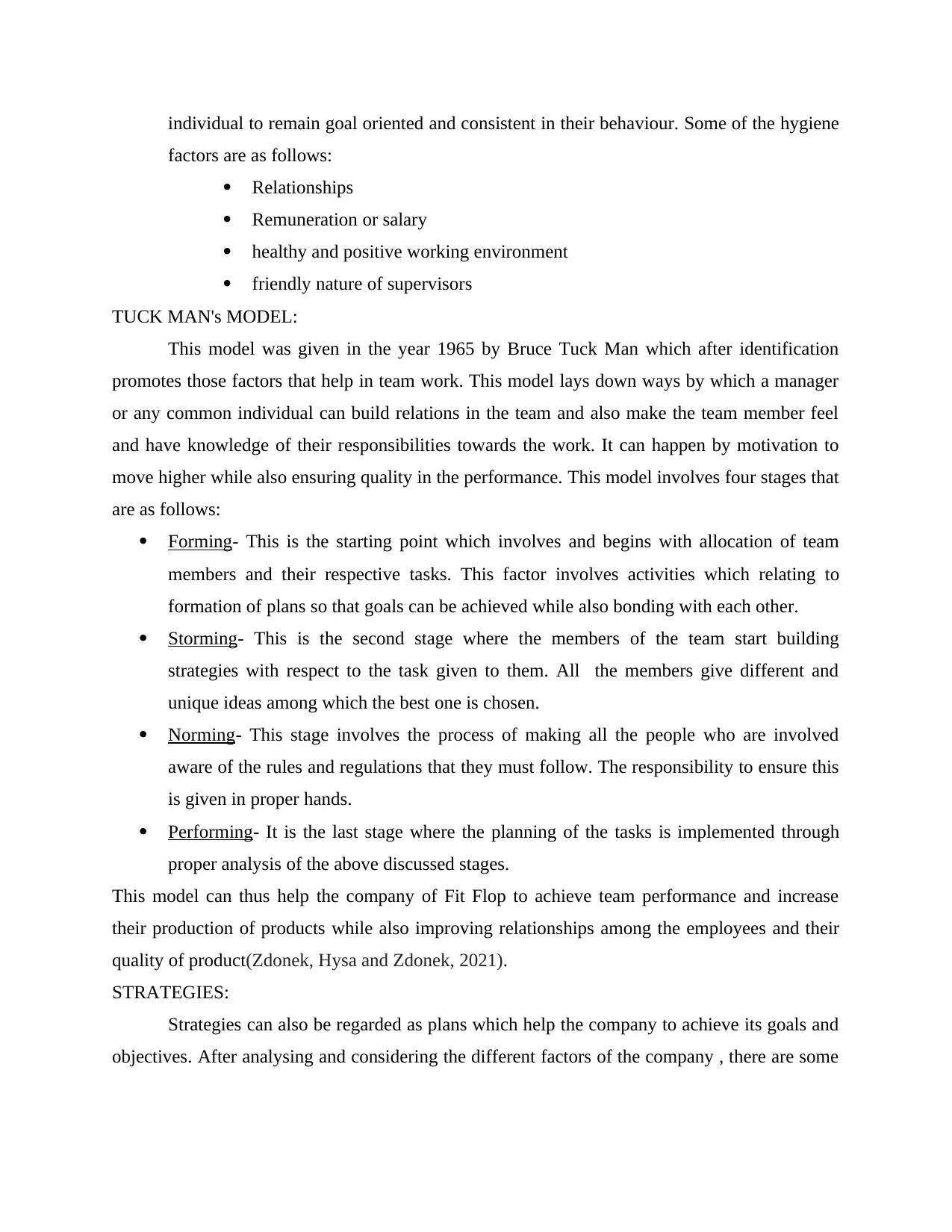
individual to remain goal oriented and consistent in their behaviour. Some of the hygiene
factors are as follows:
Relationships
Remuneration or salary
healthy and positive working environment
friendly nature of supervisors
TUCK MAN's MODEL:
This model was given in the year 1965 by Bruce Tuck Man which after identification
promotes those factors that help in team work. This model lays down ways by which a manager
or any common individual can build relations in the team and also make the team member feel
and have knowledge of their responsibilities towards the work. It can happen by motivation to
move higher while also ensuring quality in the performance. This model involves four stages that
are as follows:
Forming- This is the starting point which involves and begins with allocation of team
members and their respective tasks. This factor involves activities which relating to
formation of plans so that goals can be achieved while also bonding with each other.
Storming- This is the second stage where the members of the team start building
strategies with respect to the task given to them. All the members give different and
unique ideas among which the best one is chosen.
Norming- This stage involves the process of making all the people who are involved
aware of the rules and regulations that they must follow. The responsibility to ensure this
is given in proper hands.
Performing- It is the last stage where the planning of the tasks is implemented through
proper analysis of the above discussed stages.
This model can thus help the company of Fit Flop to achieve team performance and increase
their production of products while also improving relationships among the employees and their
quality of product(Zdonek, Hysa and Zdonek, 2021).
STRATEGIES:
Strategies can also be regarded as plans which help the company to achieve its goals and
objectives. After analysing and considering the different factors of the company , there are some
factors are as follows:
Relationships
Remuneration or salary
healthy and positive working environment
friendly nature of supervisors
TUCK MAN's MODEL:
This model was given in the year 1965 by Bruce Tuck Man which after identification
promotes those factors that help in team work. This model lays down ways by which a manager
or any common individual can build relations in the team and also make the team member feel
and have knowledge of their responsibilities towards the work. It can happen by motivation to
move higher while also ensuring quality in the performance. This model involves four stages that
are as follows:
Forming- This is the starting point which involves and begins with allocation of team
members and their respective tasks. This factor involves activities which relating to
formation of plans so that goals can be achieved while also bonding with each other.
Storming- This is the second stage where the members of the team start building
strategies with respect to the task given to them. All the members give different and
unique ideas among which the best one is chosen.
Norming- This stage involves the process of making all the people who are involved
aware of the rules and regulations that they must follow. The responsibility to ensure this
is given in proper hands.
Performing- It is the last stage where the planning of the tasks is implemented through
proper analysis of the above discussed stages.
This model can thus help the company of Fit Flop to achieve team performance and increase
their production of products while also improving relationships among the employees and their
quality of product(Zdonek, Hysa and Zdonek, 2021).
STRATEGIES:
Strategies can also be regarded as plans which help the company to achieve its goals and
objectives. After analysing and considering the different factors of the company , there are some
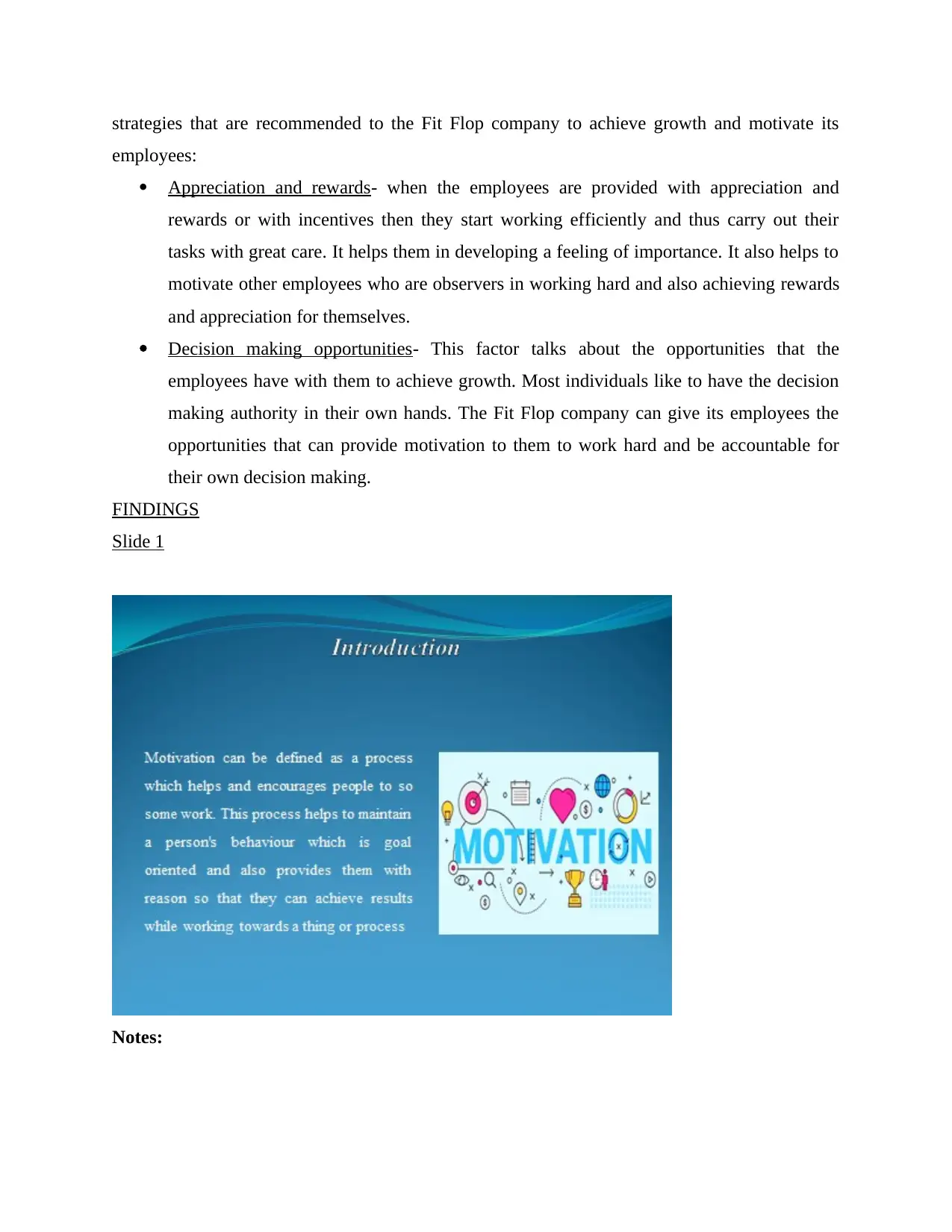
strategies that are recommended to the Fit Flop company to achieve growth and motivate its
employees:
Appreciation and rewards- when the employees are provided with appreciation and
rewards or with incentives then they start working efficiently and thus carry out their
tasks with great care. It helps them in developing a feeling of importance. It also helps to
motivate other employees who are observers in working hard and also achieving rewards
and appreciation for themselves.
Decision making opportunities- This factor talks about the opportunities that the
employees have with them to achieve growth. Most individuals like to have the decision
making authority in their own hands. The Fit Flop company can give its employees the
opportunities that can provide motivation to them to work hard and be accountable for
their own decision making.
FINDINGS
Slide 1
Notes:
employees:
Appreciation and rewards- when the employees are provided with appreciation and
rewards or with incentives then they start working efficiently and thus carry out their
tasks with great care. It helps them in developing a feeling of importance. It also helps to
motivate other employees who are observers in working hard and also achieving rewards
and appreciation for themselves.
Decision making opportunities- This factor talks about the opportunities that the
employees have with them to achieve growth. Most individuals like to have the decision
making authority in their own hands. The Fit Flop company can give its employees the
opportunities that can provide motivation to them to work hard and be accountable for
their own decision making.
FINDINGS
Slide 1
Notes:
⊘ This is a preview!⊘
Do you want full access?
Subscribe today to unlock all pages.

Trusted by 1+ million students worldwide
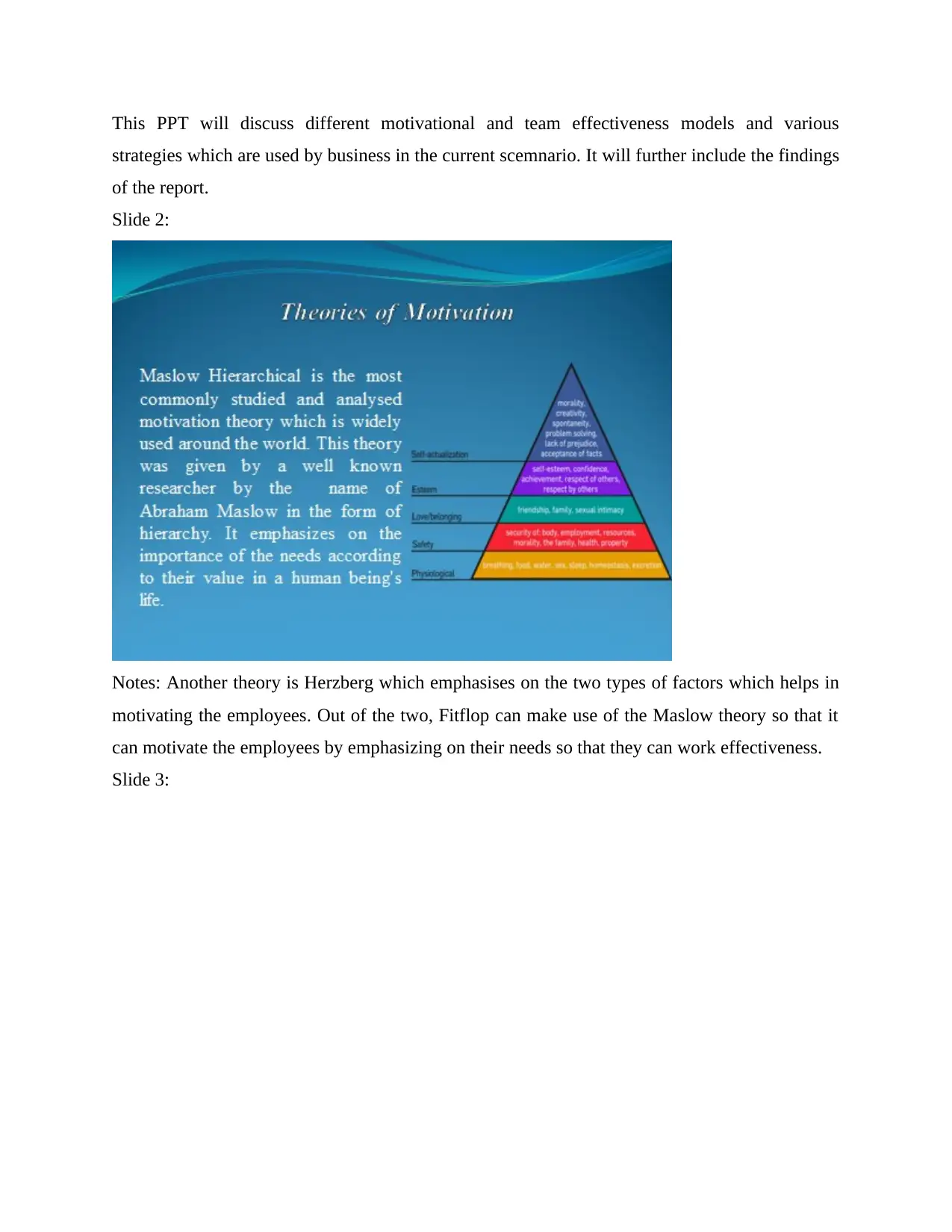
This PPT will discuss different motivational and team effectiveness models and various
strategies which are used by business in the current scemnario. It will further include the findings
of the report.
Slide 2:
Notes: Another theory is Herzberg which emphasises on the two types of factors which helps in
motivating the employees. Out of the two, Fitflop can make use of the Maslow theory so that it
can motivate the employees by emphasizing on their needs so that they can work effectiveness.
Slide 3:
strategies which are used by business in the current scemnario. It will further include the findings
of the report.
Slide 2:
Notes: Another theory is Herzberg which emphasises on the two types of factors which helps in
motivating the employees. Out of the two, Fitflop can make use of the Maslow theory so that it
can motivate the employees by emphasizing on their needs so that they can work effectiveness.
Slide 3:
Paraphrase This Document
Need a fresh take? Get an instant paraphrase of this document with our AI Paraphraser
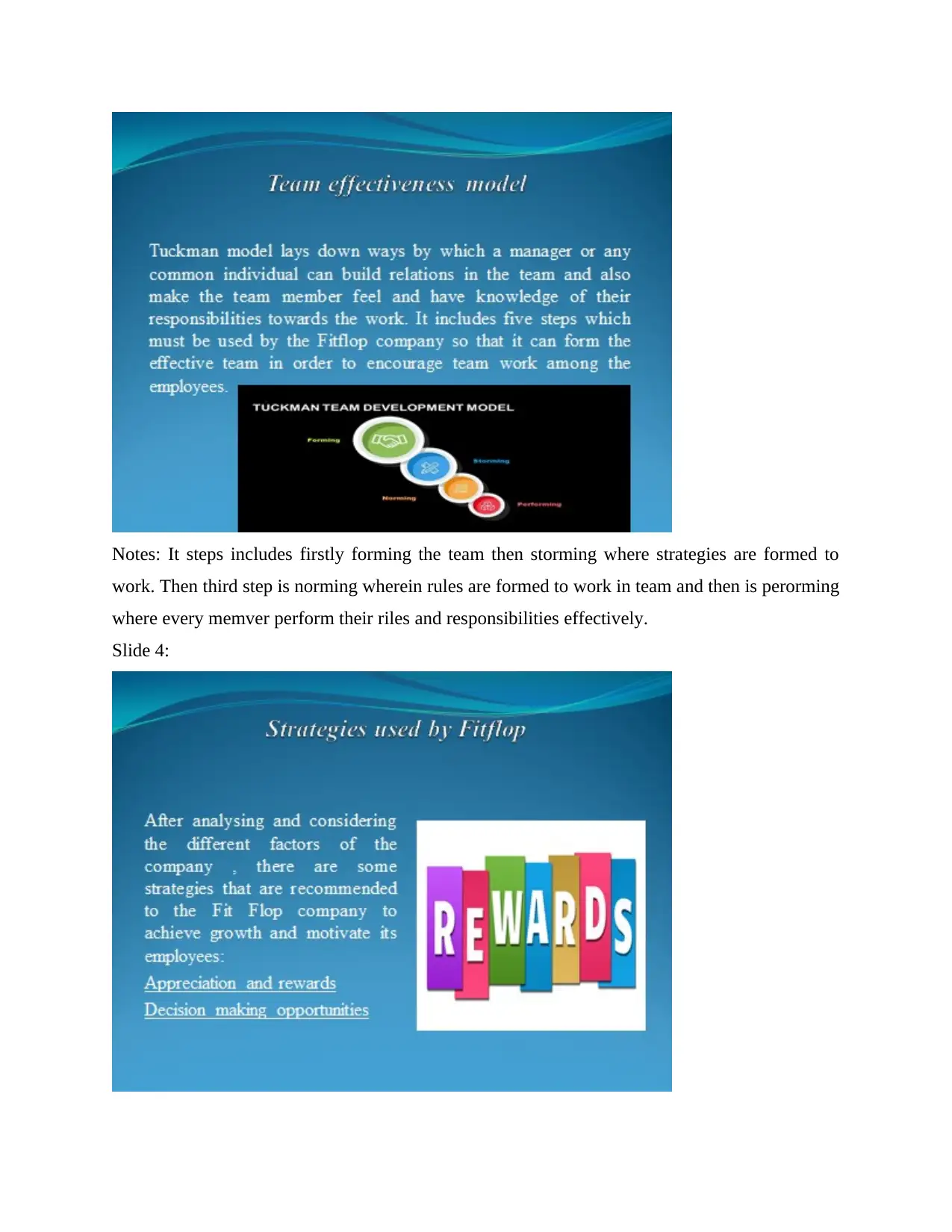
Notes: It steps includes firstly forming the team then storming where strategies are formed to
work. Then third step is norming wherein rules are formed to work in team and then is perorming
where every memver perform their riles and responsibilities effectively.
Slide 4:
work. Then third step is norming wherein rules are formed to work in team and then is perorming
where every memver perform their riles and responsibilities effectively.
Slide 4:
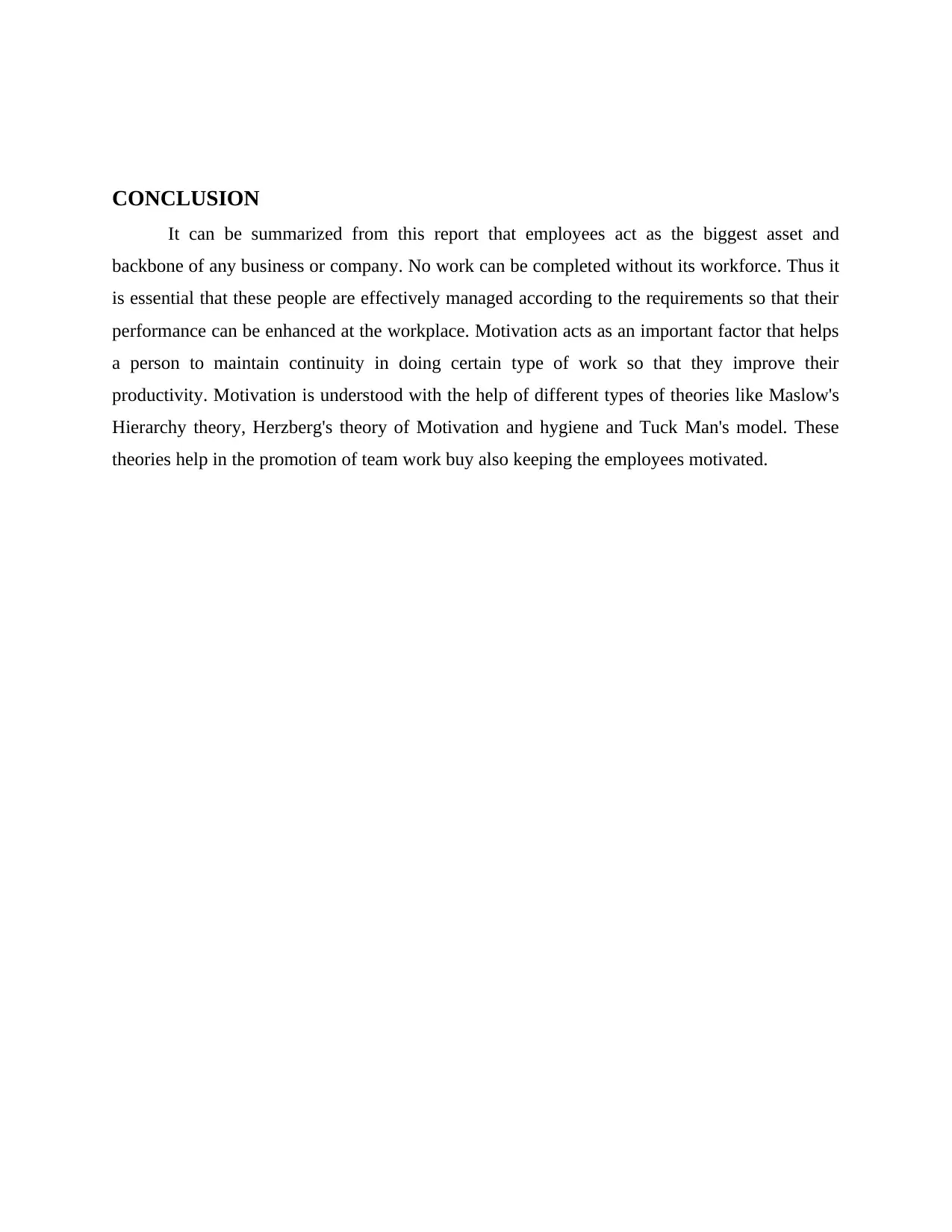
CONCLUSION
It can be summarized from this report that employees act as the biggest asset and
backbone of any business or company. No work can be completed without its workforce. Thus it
is essential that these people are effectively managed according to the requirements so that their
performance can be enhanced at the workplace. Motivation acts as an important factor that helps
a person to maintain continuity in doing certain type of work so that they improve their
productivity. Motivation is understood with the help of different types of theories like Maslow's
Hierarchy theory, Herzberg's theory of Motivation and hygiene and Tuck Man's model. These
theories help in the promotion of team work buy also keeping the employees motivated.
It can be summarized from this report that employees act as the biggest asset and
backbone of any business or company. No work can be completed without its workforce. Thus it
is essential that these people are effectively managed according to the requirements so that their
performance can be enhanced at the workplace. Motivation acts as an important factor that helps
a person to maintain continuity in doing certain type of work so that they improve their
productivity. Motivation is understood with the help of different types of theories like Maslow's
Hierarchy theory, Herzberg's theory of Motivation and hygiene and Tuck Man's model. These
theories help in the promotion of team work buy also keeping the employees motivated.
⊘ This is a preview!⊘
Do you want full access?
Subscribe today to unlock all pages.

Trusted by 1+ million students worldwide
1 out of 13
Related Documents
Your All-in-One AI-Powered Toolkit for Academic Success.
+13062052269
info@desklib.com
Available 24*7 on WhatsApp / Email
![[object Object]](/_next/static/media/star-bottom.7253800d.svg)
Unlock your academic potential
Copyright © 2020–2025 A2Z Services. All Rights Reserved. Developed and managed by ZUCOL.




